|
Reminiscences of an alumnus
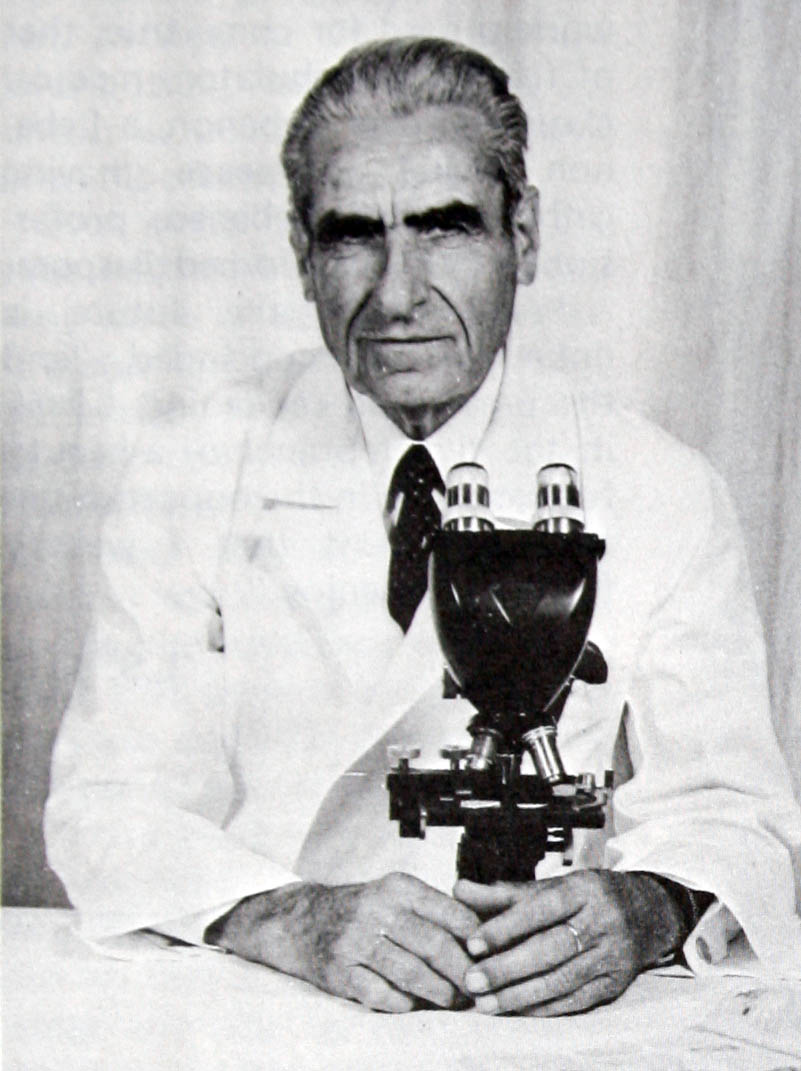
Tamer Nassar
|
A.U.B.
in the Early Thirties
Its Golden Age
by G. Fawaz Ph.D., M.D.
|
|
Oft in the stilly
night
Ere slumber's chain has bound me,
Fond memory brings the light
Of other days before me.
I do not recall who wrote these lines,
but I do know that when I see Mr. Tamer Nassar walking
on the Campus with his characteristic gait, "fond
memory" takes me back to the year 1929-30, when I was a
Freshman in College. Mr. Nassar then was often seen
with a strange-looking whitemaned but dignified old
gentleman who wore golf trousers on all occasions. He
was the renowned Dutch neurologist C. U. Ariens
Kappers, who even now is often quoted in world
scientific literature. Medical students told us that
Dr. Kappers was so fond of his young assistant that he
would not allow his photograph to be taken without
having Mr. Nassar beside him.
In 1932-33 when I was a firstyear medical
student, Mr. Nassar assisted Dr. Shanklin in teaching
us embryology and histology. These were the days when
the teaching staff of a medical science department
consisted of a professor and an instructor.
To look back now at A.U.B. in the early
thirties, it would seem in retrospect that that may
well have been the golden age of this 120-year old
institution.
The catalogue of the scholastic year
1929-30 shows that A.U.B. had 564 students in Arts and
Sciences, 107 in Medicine, 30 in Pharmacy, 11 in
Dentistry, 50 in Nursing and 30 in the Institute of
Music, a total of 801. There were then no schools of
Engineering and Agriculture. A.U.B. was one large
congenial family and was administered as such. It was
truly regional. The freshman class that year consisted
of 215 students, 40 of whom were Lebanese. The rest
came from Syria, Palestine, Egypt, Iraq, Transjordan,
Sudan, Aden, Persia, Ethiopia, Cyprus, Turkey, Bahrain,
U.S.A. and Sweden. Together the students and faculty
represented over thirty nationalities.
|
| The Brotherhood Society Cabinet,
1934-35.
|
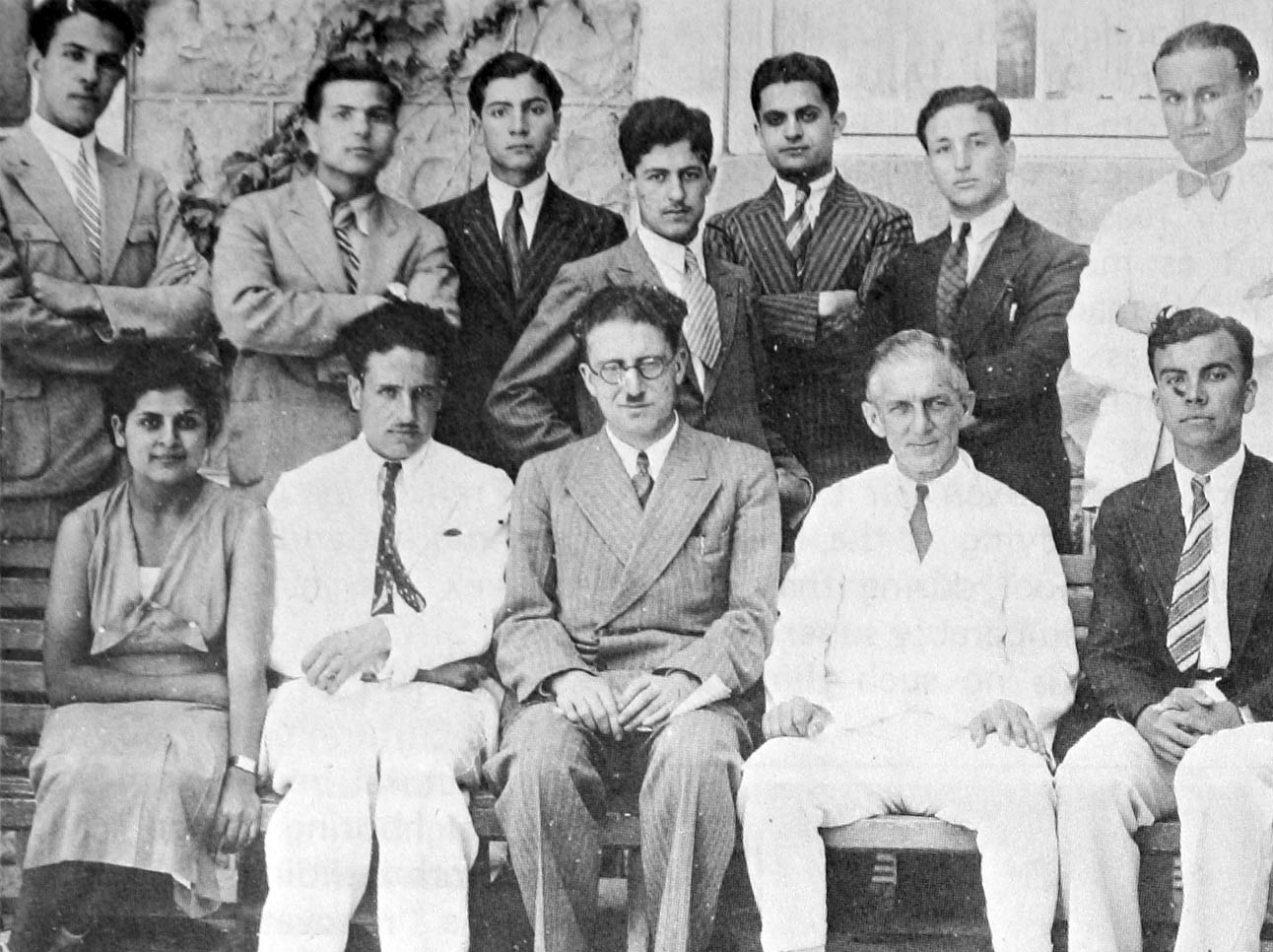
|
|
Lebanese students came from all parts of
the country. They were natives of mountain villages or
towns along the seashore like Tripoli, Byblos, Beirut,
Sidon or Tyre. The mountain villages in the North, East
and South, even the far ones like Kfeir, Hasbaya,
IbI-as-Saki, contributed their share of students and
teachers to this institution and were part of the
cultural revival that took place in this part of the
world during the nineteenth century.
No wonder that we were constantly
reminded of the words of Daniel Bliss, spoken at the
laying of the cornerstone of College Hall by William
Earl Dodge in 1871: "This College is for all conditions
and classes of men without regard to color,
nationality, race or religion."
Even our small A.U.B. handbook
which we always carried in our pockets reminded us of
this. It contained such songs as the Cedar Song
with the chorus beginning thus: "Sing to our Alma
Mater, Queen of the East is she," or the
Al-Kulliyyeh Song which ended thus: "Living as
brothers, whether Arab, Greek or Turk, We're all for
A.U.B."
There were many societies on Campus. The
most important was the West Hall Brotherhood, a
joint faculty-student enterprise which in reality was a
living miniature of A.U.B. It carried the motto: "The
realm in which we share is vastly greater than that in
which we differ," and was a utopia, but one that
worked, at least as long as it lasted. The president of
the Brotherhood was chosen yearly from among the
prominent members of the faculty, such as Dr. Dorman,
Prof. West or Prof. Zurayk.
The Brotherhood comprised many active
committees such as the Social Service Committee
which catered even to homeless street boys of Beirut.
The Deputations Committee sent out teacher-student
groups to visit high schools in this and neighboring
countries to inform prospective students about A.U.B.
The Freshman Week Committee entertained Freshman
students and made them feel at home on arrival in
October. The Social Committee arranged for
social gatherings of all sorts and among other things,
maintained a house in Antilyas where any group of
students or teachers could hold a seminar during the
weekend. The philosopher-psychologist Laurens Seelye,
for example, would take one of his classes there and
reflect on the "deeper issues of life."
Other societies like the Youth Service
Club (at one time headed by the late
Ismail-al-Azhari who later became Prime Minister of
Sudan) and the Students Union followed programs
similar to those of the Brotherhood. Then there were
many active literary societies such as
Al-Urwat-ulWuthqa.
Teachers were accessible to students at
any time and without previous appointment. Teaching was
of a tutorial nature, in practice if not in name.
West Hall, a gift of Cleveland Dodge,
father of Bayard Dodge, one of A.U.B.'s presidents, was
named after the eminent mathematician Robert West whose
son William was later a professor of Chemistry for many
years. West Hall was not only a students' union as in
other American universities, but much more. If any one
building could claim to be the cultural and spiritual
center of Beirut, it would certainly be West Hall. It
housed the Institute of Music which gave a three-year
course that ended with a diploma conferred during
commencement. The Music Institute was affiliated with
Alfred Cortot's Ecole Normale in Paris, and Cortot
himself once came to Beirut to give a piano recital in
the West Hall auditorium.
|
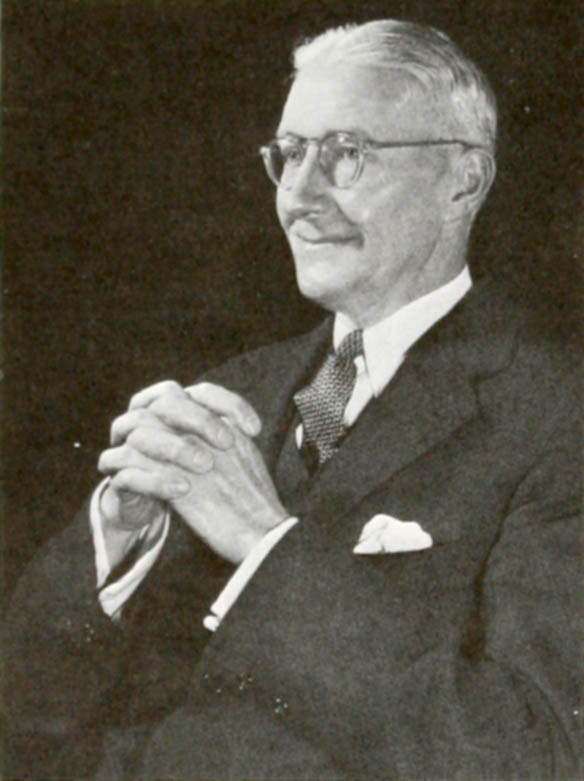
|
Bayard Dodge , President
1923-1948.
He seemed to be receiving when he was giving.
|
|
Every Saturday afternoon we listened to a
concert in the auditorium. One week it was a symphonic
concert, the next week chamber music. Many dignitaries
honored us with their presence and President Dodge had
a special row of comfortable chairs installed for such
VIPs just below the beautiful gallery that no longer
exists. Once, during the academic year 1931-32 when
President Dodge was on furlough and the Secretary of
the University, Mr. Stewart, replaced him,no less a
person came to attend the concert than the wife of the
French High Commissioner. She arrived about ten minutes
late and the concert had already started. Luckily, the
first item on the program was a 'petite suite' and she
had to wait outside only a minute or two. Yet she was
furious and she even cried. As luck would have it, I
was the first to suffer from her wrath s.ince I was an
usher outside the front door.
"Why did you not wait for me," she asked
(in French), "You knew I was coming, n'estce pas?"
I said nothing, of course. Mr. Stewart
tried to appease her during and after the performance
but I could see he was not successful. I cannot prove
it, but I firmly believe that had President Dodge been
there he would have waited for her. One of my
classmates who was also usher said to me the next day,
"You are an ass! If I were you, I would have told her,
'Madame, your husband represents democracy in this part
of the world!' " I retorted, "It is not too late. Why
don't you write her a note to this effect?"
But we had to pay a heavy price for
insulting Madame le Haut Commissaire. During the
commencement of June 1933 held on the Hockey Field, now
called The Oval, the audience had to wait for thirty
minutes until the Marseillaise ushered the delegate of
the Haut Commissaire, namely his secretary. His
Excellency, although a frequent guest at the Universit
St. Joseph never condescended to visit A.U.B. I rarely
felt so humiliated in my whole life! We often scoff at
the inefficiency, even corruption of our present
rulers, but they are our own people and we can vote
them out of office. There is nothing dearer than
freedom, especially independence from foreign rule.
Bayard Dodge (A.U.B. President from 1923
to 1948) never complained about it, but I have every
reason to believe that he had as much trouble with the
French mandatory authorities in Beirut as his
predecessor and father-in-law Howard Bliss had with the
Turkish rulers during World War I. Even our Lebanese
students studying at the French Medical School during
the thirties felt incomparably superior to us. "There
is no such thing as American medicine," they would say.
"One may talk of American technology, but not of
American culture."
But French men of medical science were in
a state of hibernation in the thirties; they were
resting on the laurels earned by Louis Pasteur and
Claude Bernard in the 19th century, while their
American colleagues were working diligently to lay the
foundations for a golden age of science.
After World War II a scientific explosion
took place in the U.S.A. At present, the march of
science there may be likened to an avalanche,
unprecedented in the history of mankind. To test my
contention, all one needs to do is to count the number
of U.S. Nobel prize winners in medicine, physics and
chemistry since 1946 and compare it with the number of
Nobel laureates in France or even in the rest of the
world. Even Lebanese graduates of French medical
schools are now modest and gracious enough to seek
postgraduate training in the U.S.A.!
Back to West Hall. It was not only a
cultural center but one of architectural beauty too. So
was the neighboring Jessup Hall before both buildings
were mutilated in a "renovation" process at the hands
of architects who received their diplomas from
Barbaryland. Fortunately, other buildings like Dodge
Hall, College HaIl,the Chapel, Post Hall, the old
Medical Building, Fisk Hall and Bliss Hall at least
retained their outside appearance, though most were
mutilated from the inside. So was, for instance, the
stately marble-floored office of President Dodge in
Dodge Hall, with life-size portraits of the
philanthropists who supported the Institution. This
once great office is now a kitchen where onions and
potatoes are peeled and from where the smell of roasted
meat emanates to the rest of the Campus. How easy it is
for man to bury and forget the past, even when that
past is adorned with glory and accomplishment!
Mrs. Dodge herself saw to it that the
buildings were kept clean and in good order. She paid
daily visits to West Hall, and supervised the staff tea
which took place every afternoon in the staff lounge.
Once a month, tea was held at Marquand House, the
President's residence, and if a staffite failed to
appear, he was sure to be gently rebuked later by Mrs.
Dodge: "We missed you on Friday afternoon."
|
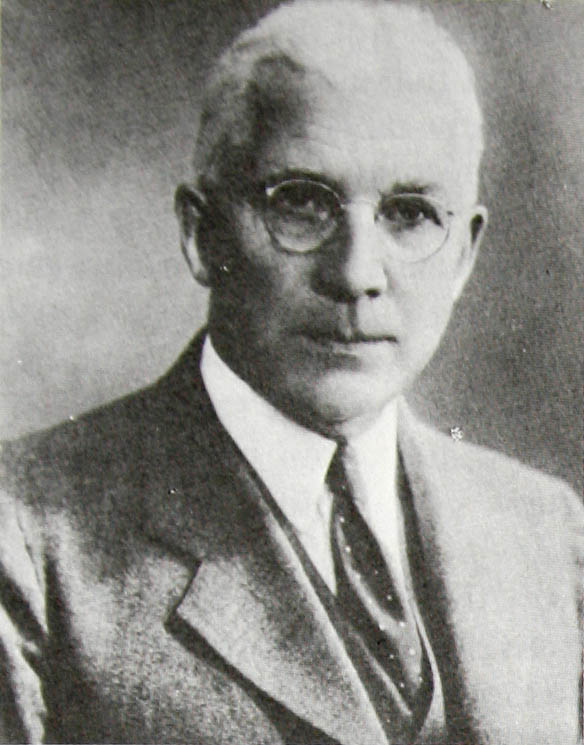
|
Edward E. Nickoly, the
Iron Dean.
|
|
Three bedrooms were also available in the
uppermost floor of West Hall for visiting alumni, who
were made to feel at home in their old Alma Mater.
During commencement week, an alumni banquet was held in
West Hall's Common Room, and alumni marched in the
commencement procession ahead of the graduating
students, so it was not uncommon to see father and son
walking in the same procession.
Only a handful of guards, gatemen and
gardeners were needed to maintain the Campus beautiful
and clean. No papers, empty bottles, tins or cigarette
butts were strewn on the grounds. The ever-watchful
dean of Arts and Sciences saw to it that law and order
were maintained. If a student was seen loitering
outside the Main Gate he was advised to make better use
of his time by visiting the beautiful library in
College Hall. What would Dean Nickoley think were he to
see hundreds of students idling for hours on the steps
of West Hall!
The President employed only one
secretary, an efficient but stern British lady who also
did all the work now performed by the Personnel Office.
She also protected the President against unwelcome
visitors. Once, a staffite took it upon himself to
"visit" the President, only to be turned back with the
remark: "The President is too busy to see people like
you." The President often typed his own letters and
memoranda and so did Dean Nickoley. There was no
purchasing department. All business matters including
local and foreign purchases were handled by the
University secretary-treasurer assisted by three or
four employees. The Registrar's Office was run by two
or three employees. The President ran the University as
though it were his own home, and the yearly deficit was
made up by payment from his own pocket. The University
was beholden to no government and the U.S. consul in
Beirut was treated on the Campus as politely as the
Egyptian consul. In other words, A.U.B. was meant to
teach and not to reduce unemployment in Lebanon.
The attitude of the students was, in
general, exemplary and left little to be desired. After
a long war, students wanted to make up for the time
wasted without proper schooling. They were just thirsty
for knowledge! They felt privileged to be college
students. Unfortunately, education was expensive and
only sons of rich parents could afford it, as one
needed 80-100 gold pounds a year, a sum of money with
which one could buy half a house in Ras Beirut.
Nowadays, students feel it is their right to study at a
private university like A.U.B. and if they have no
money, some students feel that A.U.B. is obliged to
secure the money required to teach them. Some students
feel they are doing their teachers a favor by attending
classes and still others choose as their motto the
familiar phrase coined by the late Dean Nickoley:
"Teach me if you can!"
Bayard Dodge's wisdom enabled him, during
the years of his presidency (1923-48), to keep A.U.B.
out of politics altogether. To this effect there was an
unwritten agreement between him and the students. His
arguments were simple and convincing:
While a student is still on the campus,
he can study political science in preparation for a
political career. The many literary and cultural
societies and clubs in A.U.B. were operated according
to recognized and democratic principles, and a student
could learn such democratic 'techniques' as Robert's
Rules of Order, etc. However, the actual practice of
politics was prohibited on the Campus and could take
place only after graduation, when alumni return to
their respective communities.
It is idle to think that President Dodge
took these measures in order to avoid conflict with the
French mandatory authorities. It is my firm conviction
that if Bayard Dodge were president of A.U.B. today, he
would keep it as uncontaminated by politics as during
the twenties and thirties of this century. He would not
allow any government, local or foreign, or any
political party to have a say in the running of the
Institution.
This was the paradise which I entered in
October 1929 coming from the American Merj High School,
a small piece of real estate (less than 2000 sq.m.),
consisting of a church that served as the main study
room and five or six adjoining recitation rooms. But it
is not the building that counts since, according to
Schiller, "it is the mind - or the spirit - which
builds for itself a body." The school faculty was of
high caliber and headed by a great disciplinarian and
pedagogue. K. Kurban, a graduate of S.P.C. and a
product of Howard Bliss's schooling. He Prepared us
adequately for later study at A.U.B. Besides, I had
received enough information about the College and
Medical School from my father and two older brothers.
The names Bliss, Dodge, Van Dyck, Post, Webster,
Graham, Adams, Moore, Day, West, Close had been
familiar to me since my early childhood. Thus the
transition from high school to college was as smooth
and natural as could be and I enjoyed my years at
college immensely.
On the day of my arrival, while standing
inside the Main Gate with some older students including
KhaIiI Wakim, of Mayo-Clinic fame - the President
whisked through coming from the outside. He stopped to
shake hands with every one of us making a few pertinent
remarks. I had seen him in photographs but never in
person. What a majestic figure! An aristocrat if ever
there was one, and a man of God, meek and humble. Our
headmaster in high school had seen him in action
helping needy people when, during World War I, hunger
and illness were devastating the country. He had told
us Bayard Dodge reminded him of John Henry Newman's
words defining a gentleman: "He seems to be receiving
when he is giving."
Two other prominent figures on the
Campus, E. F. Nickoley and L. H. Seelye, I had already
seen at the High School Conferences in Sidon and
Baalback, 1926 and 1928 respectively. Nickoley was the
Iron Dean of Arts and Sciences and is still remembered
as such to this very day even by the ordinary people of
Ras Beirut. He was respected, even feared but loved by
all students. But I never feared him, as I had realized
early in the game that the man possessed a sense of
humor but so subtle that not everybody noticed it. The
famous physiologist Hermann Rein once said that a good
sense of humor is an indication of good mental
health.
In the summer of 1934, the Social
Committee of the West Hall Brotherhood asked me to plan
the usual Freshman Week for new students, a week which
was meant to acclimatize students to the A.U.B.
environment. I chose ten older students to act as
guides in this program and presented the list to the
Dean for approval. He agreed to all except the only two
who came from my own district, one being the late W.
Mitri, so well-known in recent years for his social
service activities. In planning the very last evening
before classes started, I thought of offering the new
students a unique type of entertainment. Four speakers
were chosen to entertain the new class: a senior
student, Farid Yaish, a graduate assistant, Fuad
Mufarrij, an instructor, Afif Tannous and the last
speaker, the Iron Dean himself! I went to him and was
brave enough to ask him to be so kind as to tell the
boys how he himself felt when he began his Freshman
year at college. "The idea," I said, "was to make them
not only relax but, if possible, to laugh." When he
answered, he did not look at me but smiled at the
floor: "Yes, yes, you mean instead ot heavy advice."
That evening was a great success; all speakers did
well, especially Afif Tannous, but the Iron Dean outdid
himself. He not only did what he had been begged to do,
but promised to be the 'godfather' of the class, and
that for a good reason. He said that in June 1938 he
would "graduate" with them, that is retire. His last
words were: "Till then, let us do a good job. Let us
make it." The effect on the morale of the class could
well be imagined. But alas! our good Dean did not live
till 1938. He did not make it.
A few days after that memo. rable
evening, Dr. Nickoley met me on the road near Marquand
House. He stopped me and said: "I want to offer my
special thanks to you for what you have done for the
new students. I did not thank you in public as I knew
you would feel embarassed."
In the spring of 1935 when he knew I was
preparing to go to Europe for further graduate work,
he, without being asked for it, wrote for me a
recommendation along with a note saying: "This may be
of use to you." A couple of years ago, I discovered
that original recommendation among my old papers, grown
yellow with age. I have been asking myself since then
whether I deserved it. So this was our "Iron" dean!
|
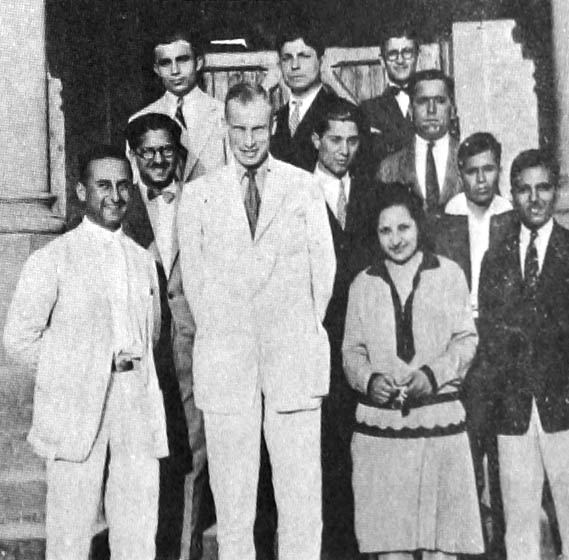
|
Philosophy class 1929.
L. to R. First row: Afif Tannous, Laurens Seelye, Alice
Tean, Zeine Zeine. Second row: A. L. Tibawri, between
Seelye and Teen. Third row: Abdul Rahman Barbir, John
Mirhij.
|
|
Another unique and extremely popular
personality on the Campus was the towering Laurens
Hickock See lye, Professor of Philosophy and
Psychology. He was over seven feet tall and a student
once enquired about the weather at the level of his
head! He was known for his originality, and once while
talking in Chapel he tore into shreds a 25piaster bank
note in order to illustrate a point. At that time you
could buy a kilogram of meat for 25 piasters! When he
spoke he magnetized and captivated his audience. He was
a great actor and you could not but note every word he
uttered. But he always had something to say, a message
to transmit. Even when he prayed he was original as
when he started with the phrase: "Great spirit of
life." He taught me social science during the Sophomore
year. However, philosophically inclined students like
Dr. Zekin Shakhashiri - a native of AlKura, cradle of
wisdom and philosophy - who took philosophy courses
with Seelye thought very highly of his philosophy.
Seelye held another prestigious post
which had been occupied by Bayard Dodge himself before
he became president, namely the directorship of West
Hall. For if West Hall was the cultural center of
Beirut, it needed an able head, and Seelye was one.
I recall how, at the end of one year, he
was taking stock of personalities of international fame
whom he had invited to A.U.B. to talk to the students:
people as different as a certain bishop who had been
chaplaingeneral of His Majesty's forces in World War I,
and, believe it or not, Gene Tunney, the World'
heavyweight boxing champion! It certainly takes a
Seelye to invite Tunney to talk to students at the
Sunday evening service in Chapel! But I never in my
life saw Chapel as crowded as when Tunney spoke. In his
speech, Tunney said among other things that he
considered Jesus a sport!" But it is a mistake to think
that Seelye collected his speakers only from among
visitors to Beirut. He invited them from all corners of
the Globe and found donors to fund such
lectureships.
The assistant director of West Hall was
none other than Dr. Zeine N. Zeine, our esteemed
Professor Emeritus of History. Zeine was polyvalent
when he started teaching. He taught me sociology and
chemistry in Freshman. During Sophomore year he taught
me social science, a multiauthored course planned by
Seelye and Nickoley, and certainly the best course I
enjoyed in Arts and Sciences.
Zeine was also Chairman of the West Hall
Ushering Committee and his love of law and order made
him constantly remind us that the Ushering Committee
was a semi-military organization! That may well be a
reason why he specialized in the history of the Ottoman
Turks! In 1968, he took my photograph in his office on
the fourth floor of College Hall, making sure that two
rows of color portraits of the BeniUthman Sultans
appeared in the background. But the Chairman of the
Ushering Committee promoted me from subaltern to
lieutenant and when my turn came to be head-usher I was
a medical student. I had to resign, realizing that
ushering and anatomy were incompatible. Zeine was one
of our most inspiring teachers and he continues to be a
great source of counsel to his many friends and
admirers.
I said that the transition from high
school to college was pleasant and smooth. It
represented a promotion. Unfortunately, the same cannot
be said of the change from Arts and Sciences to the
school of Medicine: it was a traumatic demotion, back
into the elementary school! This was on account of
gross anatomy and the way its chairman conducted the
teaching of that course. During our last year as
chemistry majors, we were treated by our three main
professors, Drs. Close, West and Constan, not only as
graduate students but even as colleagues. They were
scholars with an exquisite sense of humor, particularly
the shy professor West. I was also introduced to Dr. S.
E. Kerr the eminent biochemist who got me interested in
some fascinating problems he was trying to solve.
Now we were suddenly confronted with the
cadavers of anatomy which, with regard to color and
consistency, reminded you more of mummies than patients
on the operating table or even dead people being
autopsied. The Professor of Anatomy, as he liked to
call himself, had the appearance of a handsome Roman
emperor and he was well aware of it, for he acted like
one. I never saw him laugh, though he occasionally
smiled, condescendingly. You could not relax in his
presence, as any innocent remark could produce a
violent reaction on his part. When it pleased him to
attend the daily Chapel services, he sat on the
platform in the front row and, when possible, right
next to the President, although the front row was
reserved for full professors and he was an associate
professor. He would sit for full 20 minutes like a
statue, so much so that once our late witty pathologist
Nimr Tukan shouted to him in Arabic across the audience
"Taharrak! Move and show us you are alive!" Some
thought he was best suited to be an army general and,
indeed, he concluded his career in the armed forces of
his country. He studied medicine at the University of
Michigan and was convinced that there was no place on
earth where anatomy was better taught. He even founded
a "Michigan Club" at A.U.B. for teachers who had
studied at Ann Arbor! He thus introduced the Michigan
dissection manual of his illustrious teacher.
This is the manual which starts with the
Trapezius, Latissimus dorsi, Multifidus and
Sacrospinaus. How many precious hours were spent
learning the origin, insertion, nerve supply and action
of the Sacrospinalis in its three columns and various
parts of each column! But the Professor of Anatomy kept
repeating: "Gray's anatomy is a reference book; you
only need to learn what is clinically significant." We
soon learned, however, that the structures of clinical
significance were those which he happened to remember.
If, in the course of the dissection he came across a
small vein which he knew, then that was truly
significant; yet if he stumbled across a big artery or
nerve which he could not identify, then it was of no
clinical value.
Our Professor of Anatomy was convinced
that gross anatomy was the most important subject in
medicine. It was taught in Med I as Gross Anatomy, in
Med II as Topographic Anatomy, in Med Ill as Applied
Anatomy and in Med IV as Surgical Anatomy. I used to
read the examination questions of the advanced courses
and concluded that a first year student in June could
answer all those questions.
This reminds me of Dr. Bahij Azouri's
French teacher in Sidon who said to his students,
"Boys, we have two courses for supper tonight: Mikta
salata and Mikta arsh." During the recitations there
being no lectures - the professor would ask a student
to describe a structure while he stood at the window
gazing at the courtyard of Van Dyck Hall. As long as
the student kept talking all went well; he could say
the most absurd things on earth. But if he got stuck,
the professor would scold him as though he were a
student in a village elementary school. So the students
drew their conclusions early in the game: Take no
chances; memorize Gray thoroughly. It was indeed a
remarkable feat, but at what expense! As far as I was
concerned, the trauma to my memory proved to be
irreversible!
The Professor of Anatomy had two
associates in 1932-33, both natives of Al-Kura. Of the
two, the junior associate had a more delightful Kurani
accent! He preferred Cunningham's textbook to Gray and
while dissecting he would ask one of the students to
read to him from Canninhan.
The senior associate, M.D. 1928 (with
distinction) soon became a better anatomist than his
chief. There was no structure, no matter how small,
that could hide long from his probe, so he was the
undisputed 'master of the probe.' He also had a
phenomenal memory. Once, one of my brilliant classmates
spent a week to learn the most difficult assignment in
anatomy, namely the temporal bone, only to discover
during the recitation period that the 'senior
associate' knew it better.
The junior associate, M.D. 1931 (with
distinction), had his own way with the boss. Yet, he
learned and required from his students as much anatomy
as was required for general medical practice. He was
not like a bamboo cane, that would be swayed by a burst
of breeze, but more like a lofty mountain that could
not be shaken by a storm. He is our emeritus professor
of anatomy, still in private practice, and one of the
best - if not the best family physician in Beirut.
How did the Professor of Anatomy get
along with his colleagues, heads of the other medical
science departments? One of the senior professors said
to me a few years later, "The only way to tame the
anatomist and thus have peace during the Preclinical
Committee meetings was to elect him as chairman of the
committee!" How true to life! Did not Neville
Chamberlain tame Adolf Hitler in 1938 by offering him
the Sudetenland and thus achieve 'peace in our time,' a
peace that lasted exact. ly one year? Professor Seelye,
in his psychology course, described some teen-agers as
rebellious adolescents. Some rebellious adolescents
never mature and they usually have their way in life.
Everybody wants to avoid a confrontation, nobody wants
to have a "scene," hence "laissezfaire.
I have gone into so much detail
describing our 'professor of anatomy' because such
characters are found in abundance, especially at
universities. Not long ago, a visiting Oxford scholar
described a university as a collection of eccentrics.
Furthermore, I personally feel guilty because we are
doing to our medical students what our "professor of
anatomy" did to us, except that we have substituted
Goodman and Gilman and Harrison for Gray.
We teach medicine during four years
instead of five (as in the thirties) although
accumulated knowledge in medicine has grown
astronomically. We require so much detailed knowledge
because the students have to sit for the National
Board, ECFMG, VQE and RSVP examinations, the questions
of which may have been prepared by professors who had
studied "in Michigan!' I predict we shall soon witness
a revolution in medical education.
The course in biochemistry to which I had
been looking forward after my brief contact with Dr.
Kerr also proved to be a disappointment, although I
thoroughly enjoyed the laboratory part planned so
carefully by Dr. Kerr. Dr. Kerr was on furlough that
year and he was replaced by a visiting professor,
allegedly a great man because he was author of a
textbook of biochemistry widely used but deplorably
uninspiring. The professor from Galveston, Texas spent
the first semester reading to us verbatim from his
textbook and I can swear that my biochemistry lecture
notebook remained a blank. What a waste of time and
money, and what a difference between him and Kerr who,
as I found out when I was his graduate student, made
even undergraduates feel as though they were not only
witnessing but also assisting in the birth of an
epoch-making discovery!
During my years with Dr. Kerr, he, like
his own teacher in Philadelphia, spoke disdainfully of
people who do nothing but write textbooks. Needless to
say, there are people who are both good
experimentalists and writers of monographs and
textbooks.
At the end of the biochemistry course in
February and just before the final examination, the Med
I students held a farewell reception in West Hall in
honor of the visiting professor. Dr. Dorman, head of
Obgyn, made a short speech in which this exchange of
professorships was described as unique in the history
of medical education. How untrue, I reflected. In
reality there was no exchange. At that time Dr. Kerr
was at Harvard Medical School where he succeeded in
demonstrating the presence of phosphocreatine in brain
tissue, and isolating the substance in Beirut a year
later.
Even the course in physiology was not a
success. It made me lose my enthusiasm for physiology
and, to revive it, I had to wait for several years till
I studied it under Hermann Straub (the internist) and
Hermann Rein at the University of Göttingen. The
physiologist at A.U.B. meant well but he was very
limited. I was sorry for him because I felt he was
unjustly persecuted by both faculty and students.
|
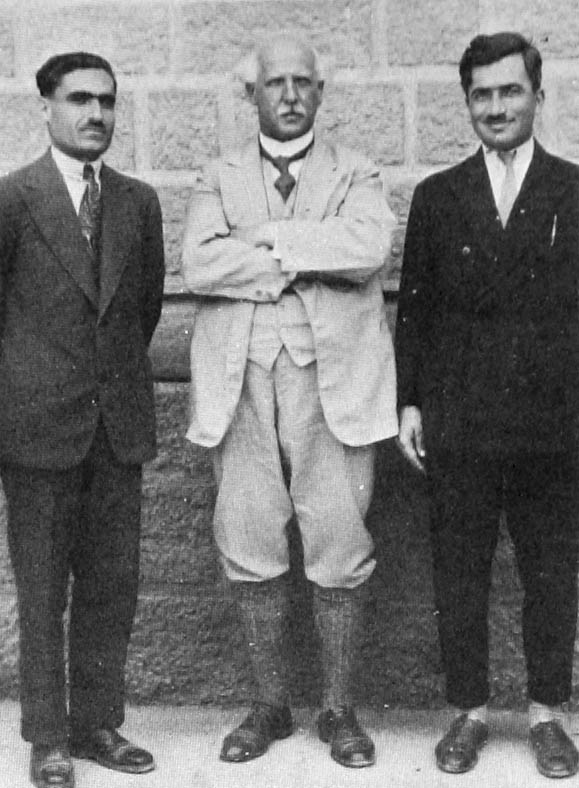
|
Dr. Kappers. At his
right Tamer Nassar
|
|
This leaves us with histology, which,
like physiology, was given in the second semester
anatomy, being anatomy, was given all year round - and
we thus return to where we started, to our dear Mr.
Tamer Nassar.
What we now call the department of human
morphology consisted then of two departments: gross
anatomy, histology and neural anatomy. The head of the
latter department was a godfearing, honest and modest
scholar. He always reminded us that he knew no more
histology than we did. His strength lay in comparative
neurology. Dr. Kappers also infected him with his own
hobby, anthropology, and like Dr. Kappers, he measured
skulls of people and also made some students like me do
the job for him. As a neurologist, however, he was
particularly fond of the brain of the chameleon and was
recognized as the world authority on that subject. He
talked so fast that he often swallowed syllables or
even words. If he asked you to identify a structure
under the microscope meaning to say: "What is that at
the tip of the pointer?", you heard only the word
pointer. When he pointed to Mr. Nassar's laboratory
adjoining the student's lab he said, "Mister Sore's
office." And to this very day I greet Mr. Nassar as
Mister Sore. It is very difficult to describe Mr.
Nassar and do him justice. Not only was Dr. Kappers
fond of him, but so were all students and faculty as
well.
Mr. Nassar reminds you of the words of
Goethe: "Edel sel der Mensch, hilfreich und gut."
(Noble be the human being, benevolent and good.)
Nothing pleases Mr. Nassar more than to be able to
assist a student in despair. He is always smiling,
composed, soft-spoken and I never saw him lose his
temper. The laboratory sessions in histology were not
only a pleasure for us but a relaxation as well. But it
is a mistake to assume that Mr. Nassar was less
demanding than other teachers. No student was allowed
to leave the laboratory before completing the
assignment satisfactorily. Three of us, the late Drs.
Hassan Idriss and Shukrallah Karam -author of the
familiar saying, "If the patient recovers, it is due to
Allah, but if he dies it is the fault of Shukrallah" -
and I were close friends and competitors as well. We
were seated together, right next to Mr. Nassar's
office. We used to finish our lab work early and demand
from Mr. Nassar a "bonus." To us, this meant a
collection of beautiful slides which Dr. Kappers had
bequeathed to Mr. Nassar. It was intended to test our
diagnostic abilities, and we appreciated the special
attention paid to us.
But Mr. Nassar could also cheat! The
laboratory part of the final examination consisted of
some twenty slides which he had just prepared for that
purpose from animal material. I had difficulty with one
slide and was annoyed. It consisted of nothing but
connective tissue! I complained to Mr. Nassar: "This
slide cannot be part of Dr. Kappers legacy." Mr. Nassar
looked at the slide, moved it, then left without saying
a word. When I looked again I saw, at the tip of the
pointer, cartilaginous tissue and realized I was
looking at a lung, but it was anything but typical.
|
| Mr. and Mrs. T. Nassar with
children. L. to R. Nabeel
(MD '65), Hilda (Medical librarian) and Khalil.
|
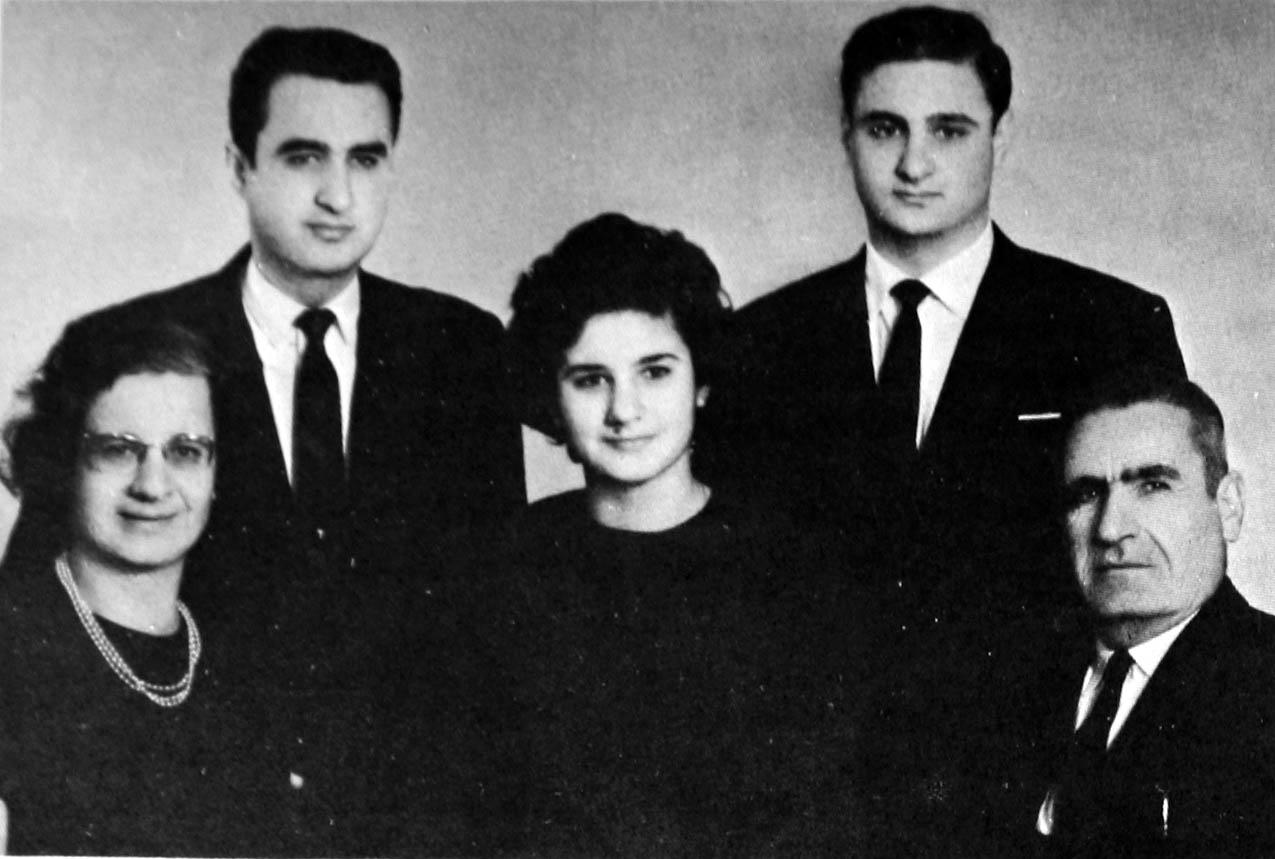
|
|
Mr. Nassar was born to an old and
distinguished family in Ain-Ksour adjacent to Abey in
the Shout mountains where in 1843, long before the
founding of the Syrian Protestant College, Cornelius
Van Dyck started his Academy.
Mr. Nassar can boast of 44 years of
full-time and 16 years of part-time service to this
Institution, and this constitutes an enviable record.
He states that one of the most rewarding experiences of
his long career has been the frequent discovery that
one or more members of a new class had been children of
his former students. For instance, we have just
mentioned Drs. Shukrallah and Hassan. Well, Mr. Nassar
takes pride in pointing out that their respective sons
Drs. Karam and Ziad, both prominent physicians are,
academically speaking, and like so many other doctors,
his own grandchildren. It is this personal element, the
so-called human touch that enriches the life of a
teacher.
Here is to Mr. Tamer Nassar, may he have
a long and active life, so he may discover among
members of a future Medicine I class an academic great
grandchild.
|
|
From "SCAN" Medical Alumni
Newsletter - A Supplement of al-kulliyah
Spring 1987
Volume 5, Number 1
(AUB Medical Alumni)
The above article is transcribed
from a copy at the AUB's Saab Medical Library.
[Back]
|
|

